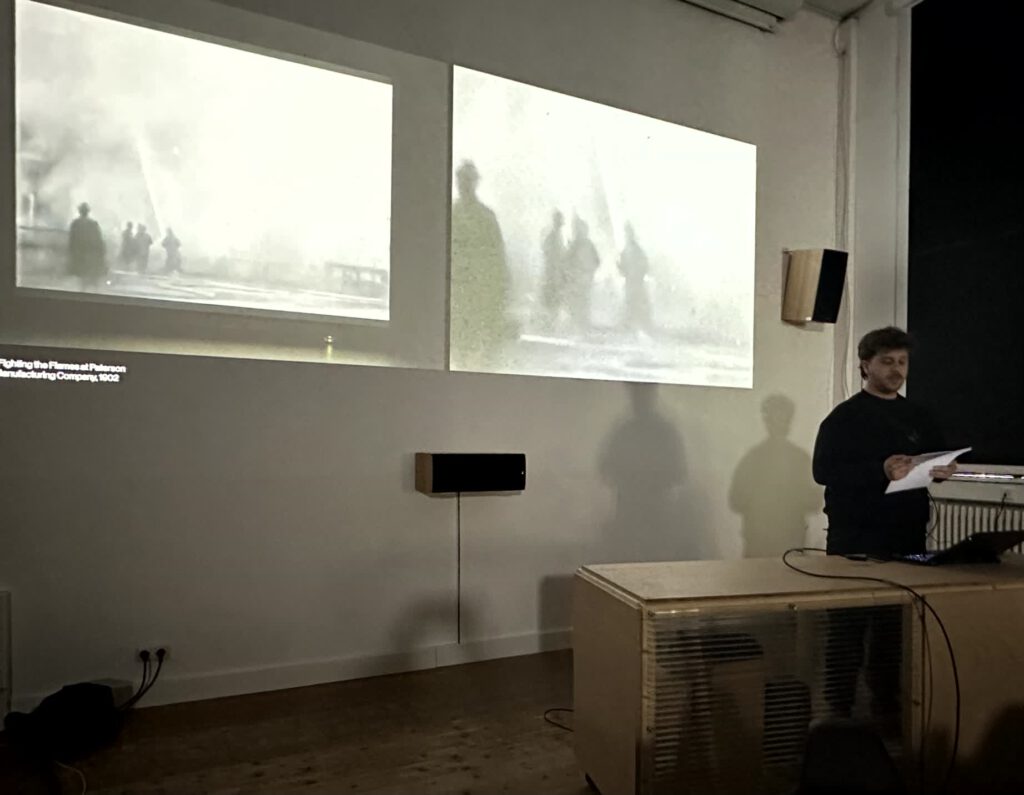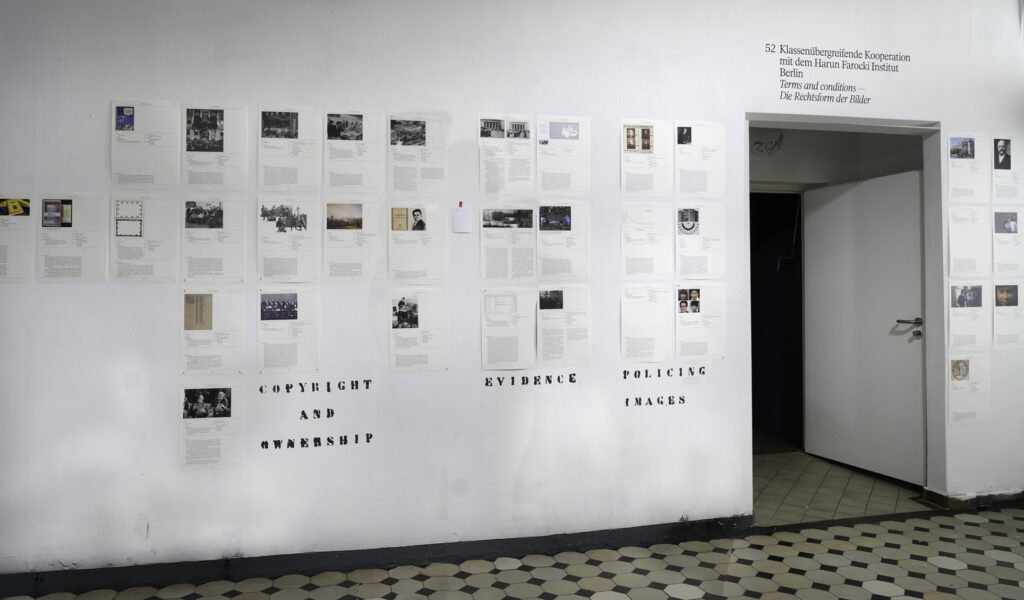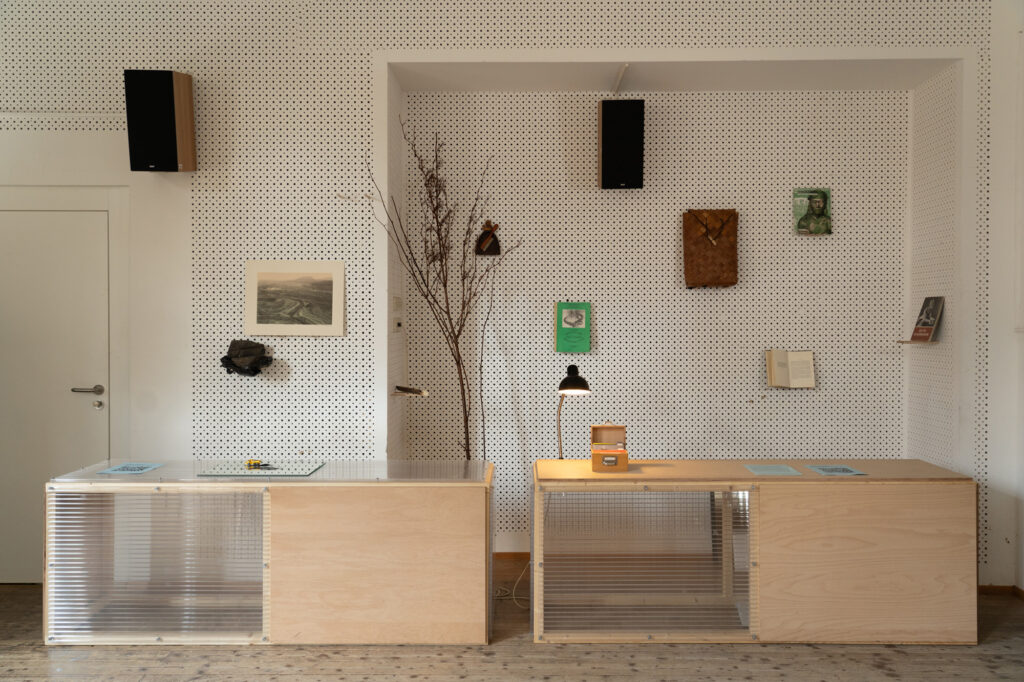Terms and Conditions examines the legal and paralegal matrix of contemporary and historical image production. Questions of material and intellectual property, data protection, visual evidence, control and surveillance structure – as operations of law – the visual culture and art of the present. The presentations during the HGB Rundgang at the HGB Leipzig in the form of performances, lectures, videos and installations form the conclusion of a year-long cooperation with the Harun Farocki Institute (Berlin). They show case studies and a collection of selected images on property, evidence and policing images.
The programme will take place in two locations, rooms 2.41 and 3.04.
The participants study in the photography and media, expanded cinema and basic media art classes:
C . Bain, Ksenia Bashmakova, Andrei Dmitrenko, Hyerin Eom, Mio Al-Hashimy, Eunjung Hwang, Tobi Fabek, David Frommhold, Elza Gubanova, Nastia Grigoriadi, Bo Heller, Simón Jaramillo Vallejo, Jakub Klíma, Anafi Kordatzaki, Yool Kwon, Shaked Levy, Daria Makarova, Yeonwoo Park, Dominik Schabel, Leon Seidel, Pascal Schiffers, Zhengke Sun, Jannis Weu, Simon Winkler, Corinna Marie Wolff, Natalia Zaitseva, Lijin Zhou, Yixuan Zhuang, Sasha Zubritskaya
Project lead: Mareike Bernien, Ines Schaber, Clemens v. Wedemeyer
Academy of Fine Arts Leipzig
Wächterstraße 11
04107 LeipzigWe particularly invite you to the live presentations on 13 February in the evening and 15 February 2025 all day.13.-16. Februar 2025
Raum 3.04
Policing Images – Installations
In room 3.04, the focus is on images that are used as a means of identification, discipline and control. This raises the question of how the standardising violence in the images can be shown, but also how strategies can be found to undermine this order.With: Andrei Dmitrenko, Mio Al-Hashimy, Bo Heller, Eunjung Hwang, Anafi Kordatzaki, Yool Kwon, Yeonwoo Park, Pascal Schiffers, Jannis Weu, Simon Winkler, Corinna Marie Wolff, Lijin Zhou, Yixuan Zhuang, Sasha Zubritskaya
Donnerstag, 13. Februar 2025
Raum 2.41
17:00 – 19:30
Film program, with Daria Makrowa, Simón Jaramillo Vallejo, Zhengke Sun (details below)
20:30
C. Bain / Jannis Weu: Phantom Pornography
(Sprache: English)
An explorative, performative juxtaposition of pornography and the operative image.
Freitag, 14. Februar 2025 & Sonntag 16. Februar 2025
Raum 2.41
Terms & Conditions Installationen und Videos
Videos and installations on the fields of copyright, evidence and policing images will be on display throughout the Rundgang in room 2.41: Copyright, Evidence and Policing Images
Anastasia Grigoriadi, installation, photographs, objects
Wild archives
After the USSR collapsed in 1991, a chaotic period of privatization began. During this time of social and political uncertainty, state archives were left suspended in buildings that used to belong to the government. They were stuck in between—between the old laws that no longer existed and the absence of new ones, between state and private ownership, between the past and an unknown future. Wild Archives is a poetic tribute to them.
Eunjung Hwang, photo installation
93(57)Scenes and Reincarnated Tongues
A reflection on the (in)visibility and familiarity of the surveillance legal system, examining the physical and mental boundaries that are created, erased, and internalized. Personal witnessing and notes are in dialog with each other.
Film program (screen) Do. 17:00, Fr./So. 14:00, 16:00, 18:00, 20:00:
Daria Makarova, Video, 9min
A red word is a lie (Ein rotes Wort ist eine Lüge)
A red word is a lie” is a poetic visual study of the socio-political landscape in contemporary Russia, focusing on the court case of A. Navalny and other political prisoners.
Simón Jaramillo Vallejo, Installation, coal, video, 6:30
Coal trails
A work about coal mining and territorial sovereignty in Colombia, consisting of a video and screenprints. The video examines coal and the territorial sovereignty of indigenous and Afro-Colombian groups, introducing screenprints of local inhabitants printed with coal dust.
Zhengke Sun, Video, 22 min 9min
Hof für Pachteinnahme – ein Kunstwerk des Volkes für das Volk
The film interweaves Chinese reforms of the rural land ownership system, changes in copyright concepts, and the development of the rule of law in the 20th century, using distinct versions of the famous sculpture group „Rent Collection Courtyard.“
(Sprache: Deutsch)
Video documentation of the events of the one-year project, ca. 8h, Monitor
with: Daria Bayer, Mareike Bernien, Alba d’Urbano & Tina Bara, Forensis Berlin, Tom Holert, Renan Laru-an, Gwinyai Machona, Doreen Mende, Ines Schaber, Susan Schuppli, titre provisoire (Cathleen Schuster/Marcel Dickhage), Mikhail Tolmachev, Clemens von Wedemeyer
A timeline in front of room 2.41 shows a collection of around 20 legal and visual events that the participants have selected in relation to their projects and gives visitors an insight into the connection between the law and artistic projects.
Samstag, 15. Februar 2025, Raum 2.41, 12:00 – 19:00 Uhr
Terms & Conditions – Der Tag der Live Präsentationen
On Saturday, students will present artistic research as case studies in the form of lectures, performances or essay films. The presentations will be introduced in specific thematic groups and accompanied by discussions with Daria Bayer, Mareike Bernien, Clio Nicastro, Ines Schaber, Tom Holert, Clemens v. Wedemeyer. The contributions are in German or English.
12:00
Policing Images
introduction: Mareike Bernien
Since the early days of photography, images have been used as a means of identification, classification and control. Visual techniques such as mugshots or criminal typologies were used to create police classification systems that were meant to categorise, pathologise and discipline people. Today, many of these techniques are taken for granted in our everyday media practices and digital environments. We use fingerprints to unlock our smartphones, facial recognition to sort our photo files, or inadvertently become training images for machine learning algorithms. How do images contribute to the policing of surveillance and identification? How can these techniques of the digitally tracked subject be made perceptible? And what strategies are there to undermine these orders in order to become unrecognisable?
Corinna Marie Wolff, live presentation
Criminal bodies or crimes against bodies – differentiating people based on their physical characteristics can be a technique of power. An examination of a form of stereotyping using the abjection theory.
(Sprache: English)
Bo Heller, live presentation
Policing Faces: The Computational Uncanny in Unhuman Images
In this lecture performance, Bo Heller rhizomatically explores how computational imaging technologies complicate our sense of the uncanny, where we find continuities and discontinuities of historical taxonomies that police faces, as well as what art can do in dismantling the very structures that do so.
(Sprache: English)
Pascal Schiffers, live presentation
Learning from a Composite Portrait
Physiognomy never really died—it just got an algorithmic upgrade. Once a pseudo-science claiming to read character from faces, it now lingers in AI-driven policing and surveillance. Using a composite as my focal point, this presentation traces how old biases resurface in new technologies, wrapped in complexity, where clarity is an illusion and opacity remains a challenge.
(Sprache: English)
Mio Al-Hashimy, live presentation
Behind the Milk Glass: Opacity, Algorithmic Bias, and the Politics of Transparency
An exploration of Édouard Glissant’s ‚Rights to Opacity‘ as a critique of biased datasets, examining how opacity can disrupt oppressive algorithms and protect individual otherness in an age increasingly driven by demands for total transparency.
(Sprache: English)
13:45 Mittagspause
14:30
Evidence
Einführung: Clemens v. Wedemeyer
Evidential images play a role in all areas of law. In the last two semesters, we analysed ambivalent evidence in various visual contexts, in criminal proceedings or war. The legal narrative before the prosecution or defence in court requires documents in order to legitimise itself. This can lead to a dispute over images: Which images and films are manipulated? What role do factors such as metadata, cultural imprinting or the medium itself play? The point of evidence must first be worked out from an image, today often with the help of technical processes to get beneath the surface of images. Works of art can also become evidence. But what status do pictorial narratives have in court?
Elza Gubanova, live presentation
Notes on Ecocide
„Notes on Ecocide“ is a series of works on the ecological implications of war-related environmental destruction. Through fragmented memories and testimonies, it explores the concept of ecocide and it’s impact on human and non-human agents, using the aftermath of the destruction of the Kakhovka Dam and the subsequent contamination of the Black Sea as a case study.
(Sprache: English)
Jakub Klíma, live presentation
Execution of The Modern Prometheus and the panorama of Assembly line — reenacted
Edison as Frankenstein: A work about cinematography and the commodification of film production, consisting of a critical inquiry into how attempts to copyright and unify diverse cinematic practices shaped its strange emergence.
(Sprache: English)
16:00
Ownership
introduction: Ines Schaber
With the invention of photography, French society was already asking who owned the images, thus linking the technical image to questions of ownership, copyright, authorship and the (creative) subject. But who owns the images, who uses them and who can oppose their depiction? What relationships exist in and around images that are not represented by questions of ownership? What practices can we invent that do justice to these relationships? The projects that have emerged over the course of the semester look at questions of ownership in former socialist and communist countries; they look at places where different notions of ownership collide; they ask how one can feel at home when one has none; they look at a tree that was planted to control land and now controls the land itself; and they examine the relationship between pornography, photography and jurisprudence and the recurring question of the control of bodies (of others).
Mio Al-Hashimy, live presentation
Who’s afraid of the big bad Knotweed/on Invasive Ecologies by Example of Fallopia Species in the UK
This lecture examines the introduction and spread of Japanese Knotweed within the broader context of industrialization, agricultural intensification, and class-based gardening trends in the 19th century. It argues that the plant’s proliferation was not an isolated or ominous phenomenon but tied to human activity and socio-economic structures underscoring the plants dual role as a cultural artefact and an ecological disruptor.
(Sprache: English)
Anastasia Grigoriadi, live presentation
Wild Archives
After the USSR collapsed in 1991, a chaotic period of privatization began. During this time of social and political uncertainty, state archives were left suspended in buildings that used to belong to the government. They were stuck in between—between the old laws that no longer existed and the absence of new ones, between state and private ownership, between the past and an unknown future. Wild Archives is a poetic tribute to them.
(Sprache: English)
Zhengke Sun, Video, 22 min
Hof für Pachteinnahme – ein Kunstwerk des Volkes für das Volk
The film interweaves Chinese reforms of the rural land ownership system, changes in copyright concepts, and the development of the rule of law in the 20th century, using distinct versions of the famous sculpture group „Rent Collection Courtyard.“
(Sprache: Deutsch)
17:45 Pause
18:15
Ownership & Policing Images
Natalia Zaitseva
Things with names are more likely to be saved
„Shortly after I moved into the flat of a recently deceased woman in Leipzig, I felt a strong connection to her things, which were telling their stories. Since I don’t have my own sentimental objects, I decided to write a novel about Christabel’s apartment and how it activated my own memories.“
(Sprache: English)
Yixuan Zhuang
The Heritage of Eyesight
This project combines elements of physical performance, vocal sound, text readings, and video projection to explore intertwined themes of surveillance, silence, and resistance.
(Sprache: English)
The room closes at 21:00.
The project was initiated by the Harun Farocki Institute (Berlin). The kick-off event took place in April 2024 in cooperation with the HGB Gallery (Ilse Lafer).
Raumgestaltung: Tobi Fabek, Dominik Schabel, David Frommhold
Grafik: Nastia Grigoriadi

Jakub Klíma

Timeline

Objects